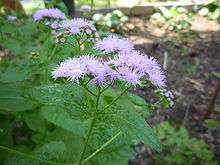Conoclinium
Conoclinium, the mistflowers, is a genus of four[1] species of herbaceous perennial flowering plants, native to North America. They are 0.5 to 2 metres (1.6 to 6.6 ft) tall, and have blue to purple or violet flowers (occasionally white).
| Conoclinium | |
|---|---|
 | |
| Conoclinium coelestinum | |
| Scientific classification | |
| Kingdom: | Plantae |
| Clade: | Tracheophytes |
| Clade: | Angiosperms |
| Clade: | Eudicots |
| Clade: | Asterids |
| Order: | Asterales |
| Family: | Asteraceae |
| Tribe: | Eupatorieae |
| Genus: | Conoclinium DC. |
| Species | |
The plants of this genus have sometimes been classified in the genus Eupatorium, but late 20th century research shows they are more closely related to other plants of the Eupatorieae, such as Ageratum.[2]
The generic name is derived from the Greek words κῶνος (kônos), meaning "cone", and κλινίον (kliníon), meaning "little bed".[3]
Species
- Conoclinium betonicifolium is found in Texas, Mexico, Guatemala[1][4]
- Conoclinium coelestinum (blue mistflower) is native to eastern and central North America, from Ontario south as far as Florida and Texas.[5] It is often grown as a garden plant, although it does have a tendency to spread and take over a garden.[6] It is recommended for habitat restoration (within its native range), especially in wet soils.[5][7]
- Conoclinium dissectum (synonym C. greggii) is found in the southern United States and Mexico (Arizona, Tamaulipas, New Mexico, Texas, Chihuahua, Coahuila, Durango, Nuevo León, San Luis Potosí, Sonora, Zacatecas).[1][4]
- Conoclinium mayfieldii is found in northern Mexico (Chihuahua, Durango, Tamaulipas)[8]
gollark: We can just say in the technical and artistic merit video that "the robot's projectile trajectory handling maths has relativistic corrections in it and would thus be equipped to fire projectiles near the speed of light, if we actually needed that, had a way to accelerate things that fast, could do so without destroying everything, did not have interactions with the air to worry about, and could safely ignore quantum effects".
gollark: If you really want to you can apply special relativity, sure.
gollark: I don't *think* we need to consider air resistance significantly.
gollark: This is fine*.
gollark: Utter υ ε ρ π.
References
- Patterson, Thomas F.; Nesom, Guy L. (2006). "Conoclinium". In Flora of North America Editorial Committee (ed.). Flora of North America North of Mexico (FNA). 21. New York and Oxford – via eFloras.org, Missouri Botanical Garden, St. Louis, MO & Harvard University Herbaria, Cambridge, MA.
- Gregory J. Schmidt and Edward E. Schilling (2000). "Phylogeny and biogeography of Eupatorium (Asteraceae: Eupatorieae) based on nuclear ITS sequence data". American Journal of Botany. Botanical Society of America. 87 (5): 716–726. doi:10.2307/2656858. JSTOR 2656858. PMID 10811796.CS1 maint: uses authors parameter (link)
- Quattrocchi, Umberto (2000). CRC World Dictionary of Plant Names: A-C. CRC Press. p. 602. ISBN 978-0-8493-2675-2.
- Turner, B. L. 1997. The Comps of Mexico: A systematic account of the family Asteraceae, vol. 1 – Eupatorieae. Phytologia Memoirs 11: i–iv, 1–272
- "Conoclinium coelestinum". Natural Resources Conservation Service PLANTS Database. USDA.
- "Conoclinium coelestinum". Native Plant Database. Lady Bird Johnson Wildflower Center, University of Texas at Austin.
- "Conoclinium coelestinum (Eupatorium coelestinum)". Native Plants for Wildlife Habitat and Conservation Landscaping: Chesapeake Bay Watershed. U.S. Fish & Wildlife Service.
- Patterson, T. F. 1996. Phytologia 80: 104-107
External links


- C. coelestinum photo from Photographs of flowering plants of the Ozarks and the interior highlands of North America, by Paul L. Redfearn, Jr.
This article is issued from Wikipedia. The text is licensed under Creative Commons - Attribution - Sharealike. Additional terms may apply for the media files.